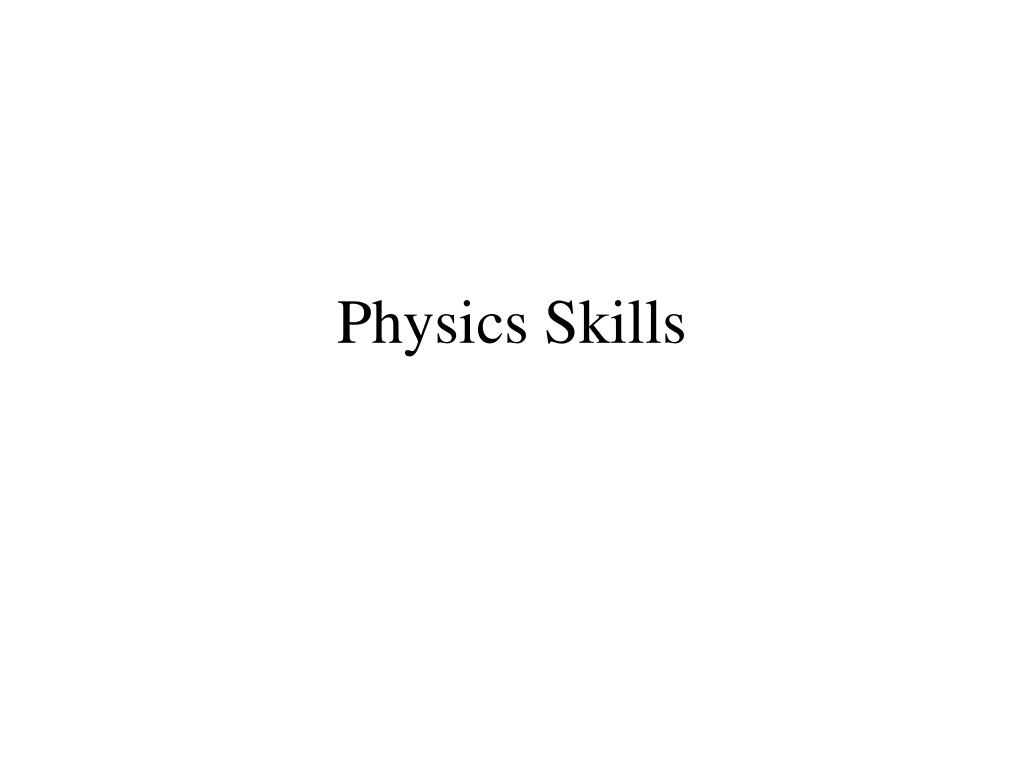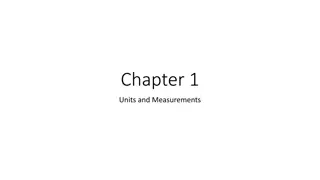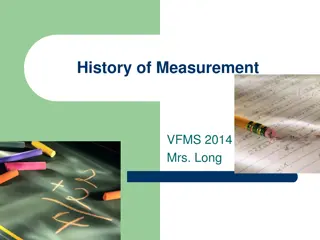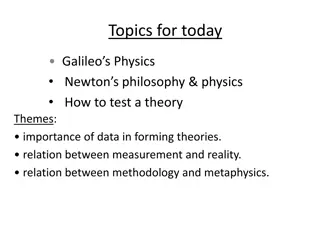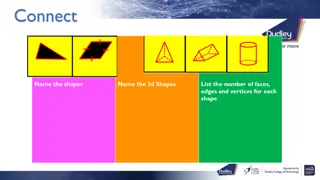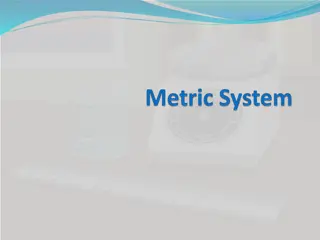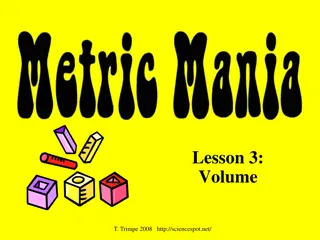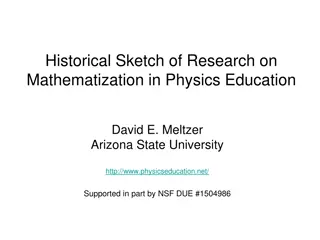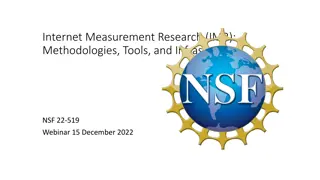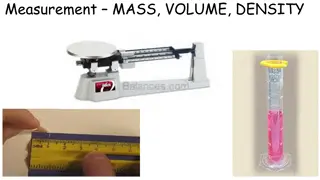Understanding Units of Measurement in Physics
Explore the world of physics through the lens of units of measurement, including the Metric System and MKS/SI base units. Learn about the standard kilogram, meter, and second, as well as derived units and the process of converting units in the Metric System.
Download Presentation

Please find below an Image/Link to download the presentation.
The content on the website is provided AS IS for your information and personal use only. It may not be sold, licensed, or shared on other websites without obtaining consent from the author. Download presentation by click this link. If you encounter any issues during the download, it is possible that the publisher has removed the file from their server.
E N D
Presentation Transcript
Units of Measurement Metric System primarily used SI Units International System of Units (SI) Also known as MKS Units Base Units: Fundamental units from which all other units can be derived.
Standard Kilogram Standard Kilogram A hunk of platinum-iridium alloy that s been housed at the International Bureau of Weights and Measures in S vres, France Kept in a air tight bell jar to help keep it from corrosion.
Standard Meter The French originated the meter in the 1790s as one/ten-millionth of the distance from the equator to the north pole along a meridian through Paris. It is realistically represented by the distance between two marks on an iron bar kept in Paris. The International Bureau of Weights and Measures, created in 1875, upgraded the bar to one made of 90 percent platinum/10 percent iridium alloy. In 1960 the meter was redefined as 1,650,763.73 wavelengths of orange-red light, in a vacuum, produced by burning the element krypton (Kr- 86). More recently (1984), the Geneva Conference on Weights and Measures has defined the meter as the distance light travels, in a vacuum, in 1/299,792,458 seconds with time measured by a cesium-133 atomic clock which emits pulses of radiation at very rapid, regular intervals.
Standard Second In 1967 the base unit for time, the second, was officially defined/standardized as: the duration of 9,192,631,770 periods of the radiation corresponding to the transition between the two hyperfine levels of the ground state of the cesium 133 atom In 1997, this definition was made even more specific with the stipulation that this refers to a cesium atom at rest at a temperature of 0 Kelvin.
Derived Units Derived Units: Units that consist of combinations of base units. Examples: volume, density, Newtons, Joules
Converting Units in the Metric System Converting from a large prefix to a small prefix move the decimal to the right Converting from a small prefix to large prefix move the decimal to the left Number of decimal places are equal to the difference between the powers of each prefix
M EAN I N G ( M U LT I P LY BY ) : P R EFI X : S Y M BO L: M AG N I TU D E : 1024 Yotta- Y 1 000 000 000 000 000 000 000 000 1021 Zetta- Z 1 000 000 000 000 000 000 000 1018 Exa- E 1 000 000 000 000 000 000 1015 Peta- P 1 000 000 000 000 000 1012 Tera- T 1 000 000 000 000 109 Giga- G 1 000 000 000 106 Mega- M 1 000 000 104 myria- my 10 000 (this is now obsolete) 103 kilo- k 1000 Other Prefixes 102 hecto- h 100 deka- da 10 10 - - - - 10-1 deci- d 0.1 10-2 centi- c 0.01 10-3 milli- m 0.001 10-6 micro- u (mu) 0.000 001 10-9 nano- n 0.000 000 001 10-12 pico- p 0.000 000 000 001 10-15 femto- f 0.000 000 000 000 001 10-18 atto- a 0.000 000 000 000 000 001 10-21 zepto- z 0.000 000 000 000 000 000 001 10-24 yocto- y 0.000 000 000 000 000 000 000 001
Converting Units between systems
SCIENTIFIC NOTATION Scientific Notation: Representing very small or very large numbers in compact form. Converting to Scientific Notation While counting the number of spaces/digits, move the decimal until it is just to the right of the first non-zero digit.
SCIENTIFIC NOTATION (continued) The number of spaces yields the value of the exponent Moving the decimal to the right yields a negative exponent Moving the decimal to the left yields a positive exponent Converting from Scientific Notation to expanded notation Preform same steps, but in opposite order/direction
Examples Given: 289,800,000 Use: 2.898 (moved 8 places) Answer: 2.898 x 108 Given: 0.000567 Use: 5.67 (moved 4 places) Answer: 5.67 x 10-4
More Examples Given: 5.093 x 106 Answer: 5,093,000 (moved 6 places to the right) Given: 1.976 x 10-4 Answer: 0.0001976 (moved 4 places to the left)
Algebra Review y = xz Solve for x x = y/z When x is multiplied by another variable/number divide both sides by that variable/number.
Algebra Review (Cont.) y = x/z x = zy When x is divided by another variable/number multiply both side by that variable/number.
Algebra Review (Cont.) y = z/x x = z/y When x is in the denominator first multiply both sides by x, then isolate x by either dividing or multiplying both sides by the other variable/number.
Algebra Review (Cont.) y = xz x = y2/z If x is under the radical sign first square both sides, then isolate x by either dividing or multiplying both sides by the other variable/number.
Algebra Review (Cont.) y = x2/z x = yz If x is squared, either take the square-root of both sides, then isolate x by either dividing or multiplying both sides by the other variable/number, or isolate x2first then take the square-root
